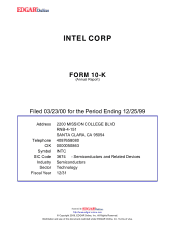Intel 1999 Annual Report Download - page 7
Download and view the complete annual report
Please find page 7 of the 1999 Intel annual report below. You can navigate through the pages in the report by either clicking on the pages listed below, or by using the keyword search tool below to find specific information within the annual report.products to give OEM customers flexibility by enabling them to choose whether to buy at the component or board level. Board-level products
based on Intel's new microprocessors are available for most computing market segments.
Sales and gross margin. During 1999, sales of microprocessors and related board-level products based on the P6 microarchitecture, which are
included in the Intel Architecture Business Group's operations, comprised a substantial majority of Intel's consolidated net revenues and gross
margin. For 1998, these represented a majority of Intel's consolidated net revenues and a substantial majority of gross margin. Sales of products
based on the P6 microarchitecture first became a significant portion of the company's revenues and gross margin in 1997. Sales of Pentium
processor family products, including Pentium processors with MMX(TM) technology, were not significant for 1999, but were a rapidly
declining but still significant portion of the company's revenues and gross margin for 1998. During 1997, sales of Pentium processor family
products were a majority of the company's revenues and gross margin. For the past several years, the company's sales of microprocessors have
generally shown a seasonal trend, with higher sales in the second half of the year, primarily due to back- to-school and holiday demand.
CHIPSETS. Chipsets perform essential logic functions surrounding the central processing unit, and support and extend the graphics, audio,
video and other capabilities of many Intel processor-based systems. The company's chipsets are compatible with one or more of a variety of
industry-accepted buses, such as the Peripheral Components Interconnect (PCI) Local Bus specification and the Accelerated Graphics Port
(AGP) specification. A bus is a circuit that carries data between parts of the system, for example, between the processor and main memory. The
company offers the 440BX AGPset family of chipsets for the Pentium III processor to be used in desktop and mobile products.
To help enable computer makers to speed their products to market, Intel designs, manufactures and sells chipsets for each computing market
segment. Intel makes chipsets with and without integrated graphics capability. Previously, the company offered stand-alone graphics
accelerator chips. However, during 1999 the company shifted its focus to integrating graphics capabilities into certain of its chipset products. In
April 1999, Intel launched the Intel(R) 810 Chipset with a 66- or 100-MHz system bus, the company's first chipset integrating multimedia
capabilities for value PCs based on the Intel Celeron processor. In September 1999, the Intel(R) 810E Chipset with a 133-MHz system bus was
introduced which extended the capabilities of the Intel 810 Chipset as well as adding support for Pentium III processors. In addition to the
integrated graphics capability, these new 800 series chipsets double the size of the communications channel within the chipset for a
significantly enhanced multimedia experience.
In August 1999, Intel began shipping board-level products with Profusion(R) Chipsets attached, aimed at the mid-range to high-end server
market segment, allowing OEMs to more easily build 8-way servers based on the Pentium III Xeon processor.
In October 1999, Intel launched the Intel(R) 840 Chipset with a 133-MHz bus, targeted for entry-level 2- and 4-way servers and workstations
utilizing Pentium III and Pentium III Xeon processors. This is the first chipset to enable high-performance Direct Rambus Dynamic Random
Access Memory (RDRAM) technology. Direct RDRAM delivers a maximum theoretical memory bandwidth of up to 1.6 GB per second. In
November 1999, Intel introduced the Intel(R) 820 Chipset with a 100
- or 133-MHz bus, for Pentium III processors. This was the first desktop
chipset to enable high-performance Direct RDRAM memory technology and enhance graphics performance through AGP 4x graphics support.
The Intel 840 and 820 Chipsets do not have integrated graphics.
Wireless Communications and Computing Group
In December 1999, Intel announced the creation of the Wireless Communications and Computing Group (WCCG), focusing on opportunities
in the growing digital cellular and wireless communications areas. WCCG's products consist of component-
level hardware and software used in
digital cellular communications products and other applications using both low-
power processing and flash memory. Within the client platform
initiatives, WCCG products support handheld devices such as mobile phones, two-way pagers and personal digital assistants.
FLASH MEMORY. Flash memory components are used to store user data and computer program code and retain information when the power
is off. Intel(R) StrataFlash(R) memory, the first flash memory product to store multiple bits of data in one memory cell, expands memory
capacity for a variety of consumer and networking applications. In August 1999, Intel introduced the 3 Volt Intel(R) StrataFlash memory with
triple the read performance compared
4




















